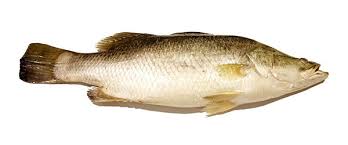Barramundi, also known as Asian sea bass, is a species of fish found in the Indo-Pacific region, particularly in the coastal waters of Australia and Southeast Asia. Here are some key points about Barramundi fish:
1. **Appearance:** Barramundi have a sleek, elongated body with prominent scales. They typically have a silvery-gray coloration, which can vary depending on their environment and age.
2. **Size:** Barramundi can grow to significant sizes, with adults often reaching lengths of over one meter (around 3 feet) and weights exceeding 20 kilograms (44 pounds).
3. **Habitat:** Barramundi inhabit a variety of aquatic environments, including rivers, estuaries, mangrove swamps, and coastal waters. They are capable of tolerating both freshwater and saltwater conditions, making them highly adaptable.
4. **Diet:** Barramundi are carnivorous predators, feeding on a diverse range of prey including fish, crustaceans, and insects. Their diet may vary depending on their life stage and habitat.
5. **Culinary Use:** Barramundi is prized for its firm, white flesh and mild, buttery flavor. It’s considered a gourmet fish and is popular in both commercial and recreational fishing. Barramundi can be prepared in various ways, including grilling, baking, frying, or steaming.
6. **Nutritional Value:** Barramundi is a nutritious source of protein, omega-3 fatty acids, vitamins, and minerals such as selenium and potassium. It’s often promoted as a healthy seafood option due to its low fat content and high protein levels.
7. **Aquaculture:** Barramundi farming has become increasingly popular due to the fish’s rapid growth rate and adaptability to aquaculture conditions. Sustainable aquaculture practices are employed to minimize environmental impact and ensure the quality of farmed Barramundi.
Barramundi is enjoyed by seafood enthusiasts around the world and is featured in various cuisines, from traditional Asian dishes to contemporary Western recipes. When purchasing Barramundi, consumers should look for sustainably sourced options to support responsible fishing practices and conservation efforts.

